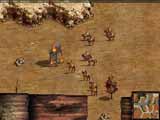 Remember
the real-time strategy glory days of ’97 and ’98, when you
couldn’t swing a cat without hitting some Warcraft II or Total
Annihilation or AoE knockoff? Remember how utterly forgettable most of
those games were? Well, playing DataBecker’s America is like a trip
back to those days of yore. Amazingly, it plays just like one of those
oldtimey RTS games, and it’s even got the same mediocre graphics,
limited multiplayer, and numbnuts AI. The only thing America’s
really got going for it is its setting, which will no doubt prompt
more than a couple of unsuspecting gamers to plunk down their money.
America is set in the American West, and you can play campaigns as one
of four “peoples”—Settlers, Outlaws, Mexicans, and Native
Americans. That sounds pretty interesting, right? Certainly more
engaging than the standard fantasy, medieval or futuristic man vs.
alien RTS, right? Remember
the real-time strategy glory days of ’97 and ’98, when you
couldn’t swing a cat without hitting some Warcraft II or Total
Annihilation or AoE knockoff? Remember how utterly forgettable most of
those games were? Well, playing DataBecker’s America is like a trip
back to those days of yore. Amazingly, it plays just like one of those
oldtimey RTS games, and it’s even got the same mediocre graphics,
limited multiplayer, and numbnuts AI. The only thing America’s
really got going for it is its setting, which will no doubt prompt
more than a couple of unsuspecting gamers to plunk down their money.
America is set in the American West, and you can play campaigns as one
of four “peoples”—Settlers, Outlaws, Mexicans, and Native
Americans. That sounds pretty interesting, right? Certainly more
engaging than the standard fantasy, medieval or futuristic man vs.
alien RTS, right?
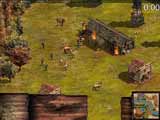 Sure.
But even the setting ends up being problematic, in part because
America’s American West is the American West as translated by
Germans whose experience of the American West seems garnered from a
few history books and a lot of television. Don’t get me wrong, even
that might not have been so bad—it might have been very cool, in
fact—but when you combine the game’s curious stabs at historical
veracity with its utterly ahistorical units and gameplay and then
cipher in a total lack of Wild West atmosphere the whole thing just
falls flat. It doesn’t help any that some individuals will probably
find at least some of the game to be offensive. The Mexican and Indian
units are treated with much less sensitivity than we post-Dances
with Wolves Americans are used to. If you’re looking to be
offended, you no doubt will be. I don’t know if we can really blame
DataBecker for this; I don’t imagine many Germans are up on the
culture wars Americans have inflicted upon themselves over the last
couple of decades. But I live in a state where we’re thinking of
changing hundreds of place names which contain the word “squaw” to
something less offensive—and when DataBecker uses the term
“squaw” for the Indian peon unit, I can’t help but cringe a
little. Sure.
But even the setting ends up being problematic, in part because
America’s American West is the American West as translated by
Germans whose experience of the American West seems garnered from a
few history books and a lot of television. Don’t get me wrong, even
that might not have been so bad—it might have been very cool, in
fact—but when you combine the game’s curious stabs at historical
veracity with its utterly ahistorical units and gameplay and then
cipher in a total lack of Wild West atmosphere the whole thing just
falls flat. It doesn’t help any that some individuals will probably
find at least some of the game to be offensive. The Mexican and Indian
units are treated with much less sensitivity than we post-Dances
with Wolves Americans are used to. If you’re looking to be
offended, you no doubt will be. I don’t know if we can really blame
DataBecker for this; I don’t imagine many Germans are up on the
culture wars Americans have inflicted upon themselves over the last
couple of decades. But I live in a state where we’re thinking of
changing hundreds of place names which contain the word “squaw” to
something less offensive—and when DataBecker uses the term
“squaw” for the Indian peon unit, I can’t help but cringe a
little.
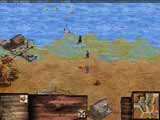 Flawed
as the potentially terrific setting is, the real problem with America
is its gameplay. While the game does include some nice little touches,
like the ability to raid outposts for food and guns or to capture and
mount wild horses, it is lacking many of the features that RTS gamers
have grown used to—like the ability to queue up farms (prepare to
spend a lot of time replanting fields) or set waypoints. No
waypoints means you often have to depend on the units to find their
own way across the map, and since the pathing AI is pretty bad,
you’ll often find them taking circuitous and dangerous routes to
their destinations. And the AI really hurts in combat. Units are very
slow to react to threats, and will often ignore enemy units that move
past them and sometimes refuse to attack units that are shooting at
them. When moving into combat, units seem to take a long time to
deploy. This means that even attacks launched at overwhelming odds can
be thwarted pretty easily by the enemy. While the game does allow you
to use different formations, they don’t seem to make much difference
in combat, and since the enemy AI seems tweaked to always be ahead of
you on the tech tree the only truly effective tactic is the old
“tank rush”--or “horse rush”, whatever. Flawed
as the potentially terrific setting is, the real problem with America
is its gameplay. While the game does include some nice little touches,
like the ability to raid outposts for food and guns or to capture and
mount wild horses, it is lacking many of the features that RTS gamers
have grown used to—like the ability to queue up farms (prepare to
spend a lot of time replanting fields) or set waypoints. No
waypoints means you often have to depend on the units to find their
own way across the map, and since the pathing AI is pretty bad,
you’ll often find them taking circuitous and dangerous routes to
their destinations. And the AI really hurts in combat. Units are very
slow to react to threats, and will often ignore enemy units that move
past them and sometimes refuse to attack units that are shooting at
them. When moving into combat, units seem to take a long time to
deploy. This means that even attacks launched at overwhelming odds can
be thwarted pretty easily by the enemy. While the game does allow you
to use different formations, they don’t seem to make much difference
in combat, and since the enemy AI seems tweaked to always be ahead of
you on the tech tree the only truly effective tactic is the old
“tank rush”--or “horse rush”, whatever.
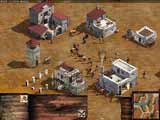 This
makes the campaigns really tough to get through, not because you’re
presented with challenging situations that you have to think through,
but rather because you’ve been so sandbagged that you’re always
playing from behind. The
solution to most scenarios is to keep producing units and attacking
until you wear the enemy down. Another problem with the game is the
predictability of the scenarios. While some of the scenarios have some
fairly interesting “triggered events”, most of them have little
bearing on the game itself, which soon devolves into the
aforementioned “build and attack” exercise. The scenarios also
seem disconnected from each other, linked together only by a tedious
narrative voiceover at the beginning of each mission. This
makes the campaigns really tough to get through, not because you’re
presented with challenging situations that you have to think through,
but rather because you’ve been so sandbagged that you’re always
playing from behind. The
solution to most scenarios is to keep producing units and attacking
until you wear the enemy down. Another problem with the game is the
predictability of the scenarios. While some of the scenarios have some
fairly interesting “triggered events”, most of them have little
bearing on the game itself, which soon devolves into the
aforementioned “build and attack” exercise. The scenarios also
seem disconnected from each other, linked together only by a tedious
narrative voiceover at the beginning of each mission.
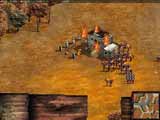 The
graphics are also somewhat dated. While most of the building graphics
are pretty good, unit sprites are indistinct and blurry, and it’s
fairly easy to lose sight of them on the map, especially when
they’re located in trees. But the most disappointing thing about the
game’s graphics is that they convey none of either the realism of
the American West or the
romance of the Wild West. The maps are unbelievably generic and bland.
As any Westerner (or Easterner who’s seen any John Ford movie) will
tell you, an essential part of the West’s mythos and allure is its
landscape. For the most part, America’s maps look like they could be
modeling Indiana. The
graphics are also somewhat dated. While most of the building graphics
are pretty good, unit sprites are indistinct and blurry, and it’s
fairly easy to lose sight of them on the map, especially when
they’re located in trees. But the most disappointing thing about the
game’s graphics is that they convey none of either the realism of
the American West or the
romance of the Wild West. The maps are unbelievably generic and bland.
As any Westerner (or Easterner who’s seen any John Ford movie) will
tell you, an essential part of the West’s mythos and allure is its
landscape. For the most part, America’s maps look like they could be
modeling Indiana.
Finally, there’s no
provision for multiplayer except over LAN. While I don’t demand that
every genre of game have a multiplayer component, it seems that
RTS’s pretty much require solid multiplayer. American doesn’t.
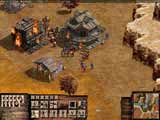 Not
like it matters much, because this game really isn’t worth playing.
While the setting is intriguing, there are much better RTS’s out
there. Unless you really miss those bygone days of 1997, I’d advise
steering clear of this one. Not
like it matters much, because this game really isn’t worth playing.
While the setting is intriguing, there are much better RTS’s out
there. Unless you really miss those bygone days of 1997, I’d advise
steering clear of this one.
Rick
Fehrenbacher |
